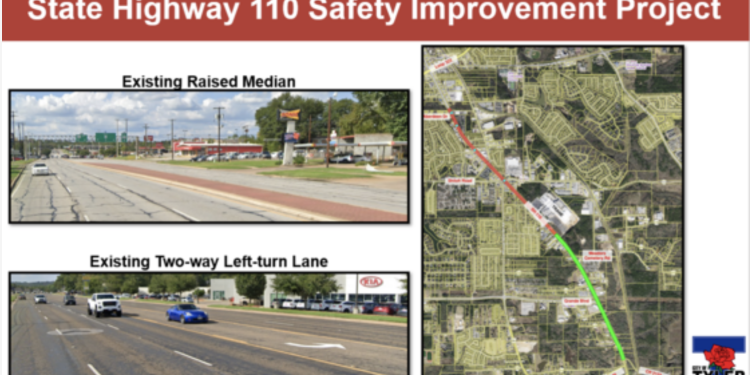TYLER, TEXAS — After nearly a decade of rising traffic accidents, the City of Tyler has partnered with the Texas Department of Transportation (TxDOT) to begin designing critical safety upgrades for a dangerous stretch of State Highway 110. The City Council formally approved the collaboration on Wednesday, June 11, in a move that aims to reduce crashes, ease congestion, and enhance overall safety for drivers and pedestrians alike.
The project will focus on a 2.8-mile segment of SH 110, stretching from just north of Aberdeen Drive (within Tyler city limits) to County Road 2123 in unincorporated Smith County. According to TxDOT data, this corridor has seen over 700 reported crashes between 2015 and 2024, with 16% resulting in severe injuries or fatalities.
What’s Being Planned
Proposed design improvements may include:
-
Installation of raised medians to better control turning movements
-
Enhanced access management to reduce conflict points
-
New roadway lighting for improved nighttime visibility
-
Upgraded traffic signals to streamline vehicle and pedestrian flow
TxDOT will take the lead on the design phase and fully fund both the design and construction, with no cost to the City of Tyler. City officials will provide input to ensure that local traffic needs and community feedback are incorporated into the final blueprint.
Why Now?
City officials acknowledge that public concern about this stretch of SH 110 has been mounting for years. The delay, according to transportation planners, was partly due to the complexity of traffic modeling and prioritization of more urgent statewide safety needs in the past. Additionally, full-scale funding for long corridors often requires multiple years of planning, data collection, and state-level budget approval.
TxDOT’s decision to move forward now is supported by compelling crash data and a broader statewide push for Vision Zero strategies, aimed at eliminating traffic fatalities across Texas roadways.
Expected Outcome
While specific construction timelines and total cost estimates have yet to be released, preliminary projections suggest construction could begin as early as 2027, following the completion of design, environmental clearance, and public comment periods. Similar corridor projects across Texas have ranged between $15 million and $40 million, depending on features and right-of-way requirements.
The goal is to significantly reduce both the frequency and severity of accidents along SH 110. With improved access controls and better visibility, officials expect to see:
-
A 30–50% drop in crash rates within the first 3 years after completion
-
Smoother traffic flow during peak hours
-
Safer conditions for pedestrians, especially near residential and commercial zones




